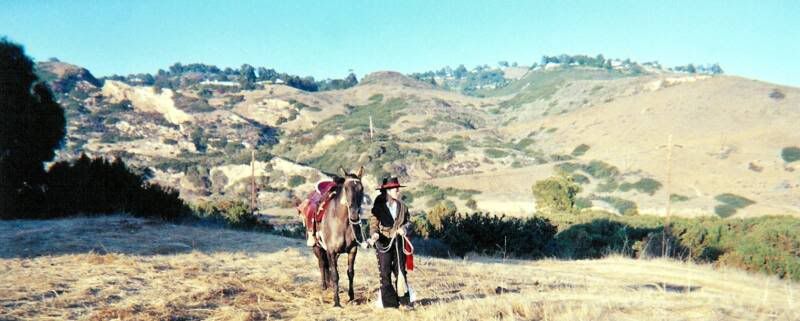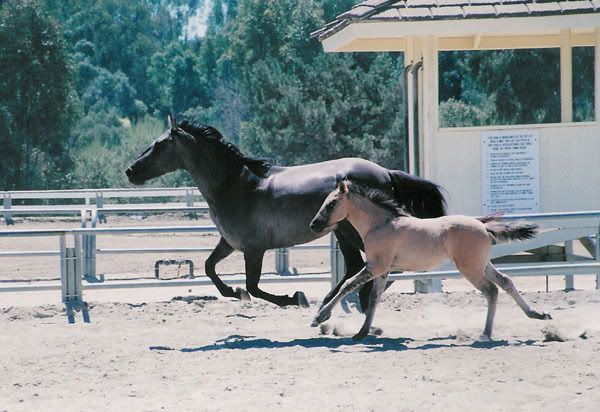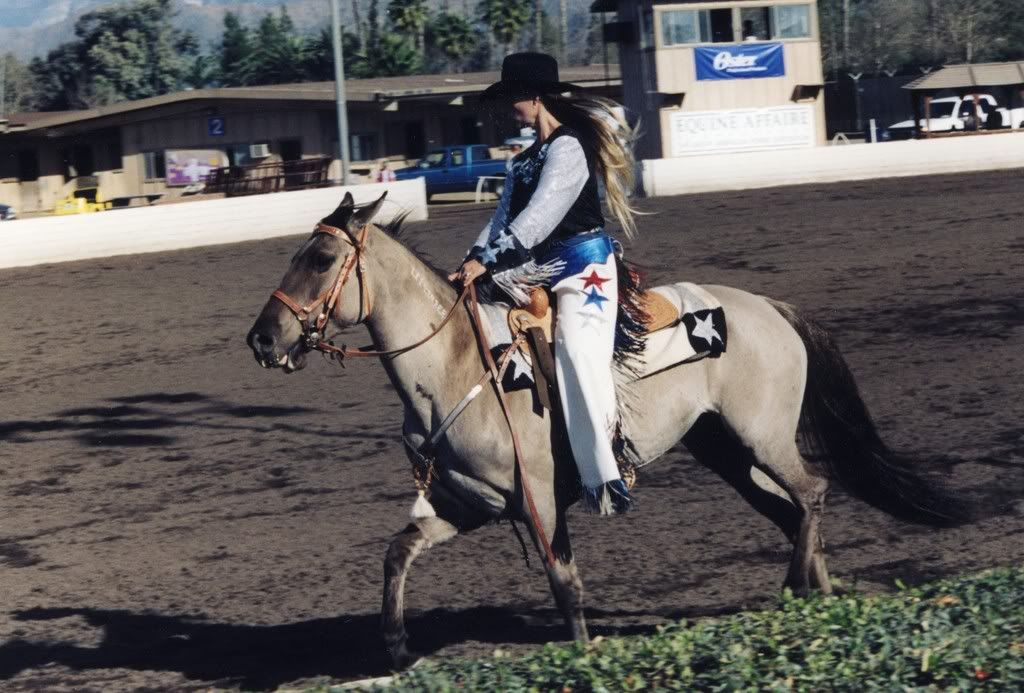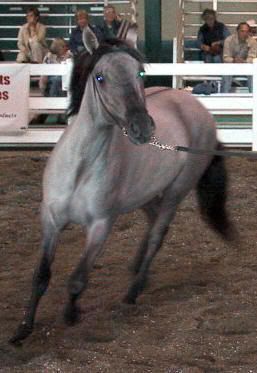OBSERVATIONS
Gus Warr invited me to go with him on a horse trapping project in the southern part of the Sulphur Herd Management Area. The trap consisted of metal corral panels with long wings of burlap material extending out from the corral in a V shape. A helicopter was used to push the horses into the trap. Five attempts were made to drive groups of three to five horses into the trap. Only one attempt was successful, and five horses were caught during the entire day. I gained a greater appreciation for the difficulty in catching the Sulphur horses. The weather was very cold and windy with frequent snow flurries. I also gained an appreciation for the work that the BLM men have to go through to catch horses, and their frustrations when projects are not successful. They tried to trap horses at a different location the following week and came out completely empty handed. Seeing the difficulties in trying to catch horses nowadays confirmed, to me, how the wild horses of the Mountain Home Range could have been impossible for the mustangers of years past to completely catch or kill out.

Craig Egerton told me that there are probably horses in the Sulphur herd that men have never seen before. During my few travels through the area I have found it difficult to find or see many horses, due to the dense stand of pinion and juniper trees. Craig also said that during the last time he was out to the Sulphur Herd Management Area, he saw a herd of horses on the hills to the west of the Mountain Home Range across Hamblin Valley. He thought these were probably the horses they had been wanting to catch, and the commotion the BLM was making in the area, had driven the horses completely out. Craig said the horses would probably return after things quieted down. Elk will do the same thing, when there is any human impact on an area they are in, they will move completely out. This again shows the wild nature of the Sulphur horses.
Another unique characteristic of the Sulphur horses, as pointed out before, is the color, and especially the prominence of dun factor horses in the population. Of the horses that were adopted out during 1992 and 1993, I could account for 148, though there were a few more. I was told that this was a good representation of what is in the total population on the Mountain Home Range. Out of the 148 horses, there were 22% buckskin, 18% dun, 16% grulla, 14% bay, 11% black, 9% chestnut, 8% sorrel, and 2% brown. (The colors are BLM terminology. The buckskins were actually line backed horses with black points, and the duns were various forms of red dun.) Over half were dun factor horses, 56%, which shows the strong influence of this color in the population.

At one time I thought the dun factor Spanish mustangs in the United States were actually Spanish Sorraias. I wrote to Dr. Phil Sponenberg about this, and he wrote back, concerning the Sorraias: "They are a remnant of a primitive type of Iberian horse. It was not Sorraias that were brought over to the New World, but rather it was related Iberian types. As a result, any horses in the New World with these line backed colors are not descendants of Sorraias, but are probably cousins of some sort or another.,, The dun factor coloring with the right conformation is very characteristic of Spanish type through descent from the Iberian horse. I have seen pictures of Sorraias in various horse books, and many of the Sulphur horses I have seen look just like them, both in color and conformation. In describing the Sorraia, Encyclopedia of the Horse states: "It is a true 'primitive' having characteristics of both the Tarpan and Przewalski and being extremely hardy it is able to survive on the very poor vegetation available, whilst withstanding the extreme climatic conditions." Exactly the same description can also be said for the wild horses of the Mountain Home Range.

I looked at several Nevada mustangs that were being held in the BLM's Delta corrals. These horses looked to have some Spanish blood in them. They were small, had low set tails, and a sloping croup. There were many bays and blacks and a few dun factor horses. They had common heads, though, and were generally course looking. The wild horses from the Mountain Home Range, on the other hand, have stronger Spanish type features and appear to be a higher grade horse. I have read references of Chief Walkara and his Utes stealing the finest Spanish horses out of Southern California. If there is any truth to this, and these horses escaped from the Utes to eventually populate the Mountain Home Range, that could explain the better features of the Sulphur horses.
I wondered what would attract horses to the Mountain Home Range if they did escape from Spanish horse herds being driven across the Old Spanish Trail Gus Warr told me that the Needle Range probably had more water than any range west of Cedar City. Gale Bennett also told me that of the routes going north to the Sevier River, Pine Valley also had the most water. This could have been a possible route for horse traders such as Miles Goodyear to have driven their horses on their way to Northern Utah and Fort Bridger. Undoubtedly, Ute Indians drove horses through Pine Valley also.

Most people I interviewed said the Mountain Home Range horses won't mix with domestic or other types of horses. Last summer I put a friend's mare, which was daughter of an adopted Rock Springs, Wyoming mustang, with my Sulphur stallion and mare with her foal. My three horses would not have a thing to do with my friend's mare and actually avoided her.
Present day description of Spanish mustang conformation is very specific. I have seen that the Sulphur horses may sway from this slightly. In some horses I see a wider chest, larger chestnuts, and longer ears. I wonder if the Spanish horse of southern California, later to be captured by Ute Indians and eventually escaping to the wilds of the Needle Mountain range, may have developed certain characteristics of their own. On the other hand, they may still carry the same characteristics of the old southern California, Spanish horse, or be tainted with the blood of domestic horses. In Dr. Sponenberg's North American Colonial Spanish Horse Update.
August 1992, he writes: "The original Spanish type was more variable, including some horses with higher set tails, broader chests, and rounder conformation generally." In Cunninghame Graham's Horses of the Conquest he writes: "Forced to rely upon themselves for their protection, all the descendants of the Spanish horses throughout America developed characteristics that in the course of centuries rendered them very different from the Spanish type. Possibly by reason of being obliged to think and to rely upon themselves, their heads grew larger and their ears, always strained to catch the slightest sound, grew longer and more mobile than those of horses stable-fed and cared for from earliest years."

If behavior is any indication of difference in breeds of horses I certainly see this in my Sulphur horses. In the seven-acre area that I kept my three horses and my friend's mare, I also have a five year old buck mule deer. My horses had closer contact with and acted more like the deer than they did my friends horse. At any noise or movement, they erect their heads with ears extended just like the deer. Of course, this is probably due to their former existence in the wilds of the Mountain Home Range where predators like coyotes and mountain lions are prevalent. The foal I have, though, which was born in captivity, acts just like the other horses. There are no confirmed southern California, Spanish horses left to make comparison, so determination of Spanish lineage is subjective. Positive proof is impossible, and again the horses are at the mercy of personal opinion.
I need to see pictures of the "horns". My friend Richard (Rick) Davis has a stud with them.
ReplyDeleteGlen "Bear" Smith.....uncleglen98@msn.com
Thanks
Bear
I have a buckskin paint mare, line back, zebra stripped from the Navajo Reservation. I worked there for a few years. Her mother was the result of a Navajo raid on Ute Mountain horses across the San Juan. She is extremely beautiful - and gaited! She is line backed and very honey colored with white spots. Her features are very fine with an almost Arab type head. She is also the most feminine mare I have ever seen with an extremely gentle nature. No one can tell me why or what type of gait it is. I also have her first colt. She was bred somewhere in Monument Valley before she was moved to another ranch west of Kayenta. He is an amazing silver horse with perfectly balanced Andalusian traits. He was more dun color, then turned silver at about 6 years old. When he was a stud, I rode him rock hopping on a big ranch in Arizona. He was very careful and always looked up to determine how I was doing. He used to sale about 25' - 30' on a line or under saddle. Or he would jump a 18" cattle feeder and land on his hind legs. His color is not white - it is a very shiny silver. He glows in the moonlight like magic. I can see him from my bedroom window. The quarter horses where not brought out there until recently when the team roping craze hit the rez. He has a very Andalusian head, short powerful body and was a very stylish and showy boy when he was stud. I also have another 3 year old filly from the same mare. She is turning more silver and is getting very tall. Very gentle nature and accepted the heavy roping saddle without hesitation. Looked at the saddle, looked at me, and walked off. She also has Andalusian type traits and uses her front feet in the Andalusian way - like weapons until she learned better.
ReplyDeleteAll my mares colts have a silver frost on both sides of their manes. This seams to be a dominant trait and could give some clues as to where they came from. They are all very different from any horses here in north central New Mexico - the Spanish influence is noted. I keep them very close to the house. I am interested in finding out more information about my horses. They are so unique and beautiful in all ways. I saw an article in New Mexico magazine a few years ago with a picture of a Ute Mountain Mustang who could have been my mare. Same spotted honey colored dun. All her babies have been line back and zebra striped.
Any information would be appreciated. I have good photos available. Will try to figure out how to post them. Thanks.
In reading through these posts, I notice people do not seem to understand the difference between open range horses and contained, domestic horses. It is almost like a different species. My two geldings were studs until they were 13 and 6 years old. We used to chase off the incoming open range studs with the Andalusian cross stud. The quarter pony boss will put the others in a safe place out in the meadows where we live and will not let them move until he has determined if it is safe. He will also take the other gelding and go after any idiots who decide to try to bad mouth me for any reason. I am like their favorite girl. I do not mean jealous type of behavior. All domestic horses will do that. This was a group of 6-8 men cursing at me and accusing me of calling the branding inspector - I did not do that, another neighbor did. Out of the corner of my eye I saw the boys head up the hill toward the men. I mean a flat out gallup (past a wide open gate) in a planned approach with an aggressive wild horse posture, then standing in a group of men on their hind legs to show them what they've got. This is typical territorial behavior of range studs. These men were standing in awe when I called the boys and they stood calmly by me while I opened the gate. Then stood and waited for me on the other side of the gate. These horses have been very curteous to all other visitors and neighboring ranchers - rarely leave the meadow, etc.
ReplyDeleteI have a hundred stories like this.
hello Janeinthemtns, please send me an email. I would love talk with you.
ReplyDeleteweyekin@hotmail.com
ReplyDeletehelped me with my homework
ReplyDeleteI adopted a mare from the sulphur herd last year, she is dun with stripes on her legs,line backed , bi-colored mane...seems to show all the morphological markers of Spanish blood, she does have white feet and a star in her forehead. I am looking for a Sulphur stud to breed her to. Is anyone aware of anyone standing a Sulphur or Kiger stud in Utah?
ReplyDeleteA Kiger is not at all the same as a Sulphur. Totally different kind of horse. The Sulphur represents the very last of the Spanish horses of California, the Kiger has an unknown origin and was collected off of various HMA's in Oregon that were of a dun color and placed on the newly made Kiger HMA and also on the Riddle HMA. They are not genetically related whatsoever and are totally different in type, movement, and temperament. So, I cannot recommend breeding a Kiger to a Sulphur mare. Especially being that the Spanish type Sulphur is on the verge of extinction!
ReplyDeleteI know of a grullo Sulphur stallion that I have liked for years that is in UT. Email me if you would like to know the details.